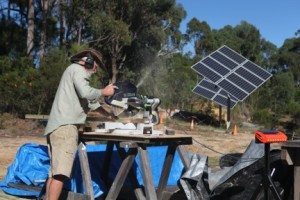Off-grid in the Hawkesbury, with tracking solar and batteries
When Colin and Jenny Burgess moved to their ‘little stone cottage in the bush’ they knew they wanted to install their own energy storage.
And with a quote of around $240,000 to connect their property to the electricity grid, the couple’s choice was justified and they started designing an off-grid solar system to suit their energy needs.
“When we started building over 20 years ago, the cottage was to be a weekender, but by the time we had a roof, doors and windows there had been quite a few changes; we were grandparents and just the two of us in the family home,” Col Burgess says.

“Our little cottage was better than originally envisaged and we had watched too many sunsets through the bloodwoods to be occasional visitors.
“Grid power was out because of the estimated cost of connection, but also due to our location; it would have taken negotiation, costs of acquiring land and clearing an easement through thick bush to the nearest power line over three kilometres away.”
While the couple considered other options for their bush sanctuary, solar, with a back-up generator, proved to be the best option.
“Diesel power was possible but there would be the continuing cost of fuel and, although we could isolate the generator to some extent, there would also be noise.”
Their standalone solar system was installed and commissioned in July 2012, designed to meet their energy needs to run appliances such as a dishwasher, washing machine, sound system, desk and laptop computers.

“We have sixteen solar panels that make up a 3.2 kilowatt system and which are mounted on two tracking towers that wake up to face the rising sun each morning and follow its passage at 15 minute intervals until sunset,” Col Burgess says,
“It’s claimed that tracking the sun improves energy generating efficiency by up to 30%. Whatever the figures, the batteries are fully re-charged by midday most sunny days. In simple terms, computer smarts built into the system mean that once charged, demand is met directly from the panels during the day and excess power is dumped, helping to extend battery life.
“The cost of going off-grid was substantial, but the result has been excellent. We use gas for cooking and the hot water comes from a gas-boosted solar system.
“Our system could support limited air conditioning in summer and any welding I do is made possible by tapping directly into the 9.5KVA back-up generator. A smaller generator may have been sufficient back up for the batteries but the requirement was the ability to weld.

“All lights in the main living areas are five to ten watt LEDs and in the bedrooms and bathrooms there’s a variety of quartz, fluorescent and low voltage globes. We are probably more self-conscious about turning off unnecessary lights than we were in our days on-grid, but as empty-nesters we don’t have to worry about teenagers leaving lights on around the clock!”
Outside, Col uses an automatic pump to provide pressurised water to the house from an in-ground tank, while another high-pressure pump, used for fire fighting, delivers dam water. A third pump transfers waste from the septic tanks to an absorption trench.
The couple said that despite a few minor annoyances, their off-grid lifestyle has been the right one for them.

“A small problem is remembering to start the back-up generator at regular intervals to keep it in good operating condition. That’s really only needed once or twice a year to produce power.”
“The battery bank will last ten years, but we’re optimistic that battery costs will have come down by the time they need replacing. There’s reason too to be optimistic that over the 20-year life of the solar panels, the cost penalty of a little stone house in the bush won’t be bad at all.”
“But it’s satisfying to turn on a light or power tool and know the energy was generated only a few metres away. Sometimes the power tools run in sight of the energy source.”
“It’s a feel-good experience of independence from the grid and those nasty quarterly bills, pure and simple.”


